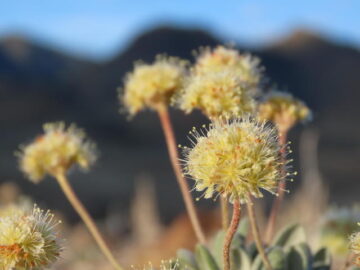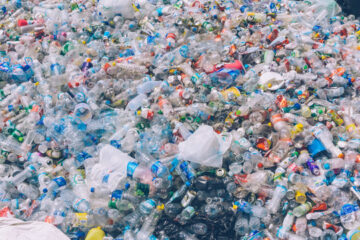by Leanne Ogasawara

1.
In the high desert of Nevada, a little wildflower is seen clinging precariously to barren rock. We learn that this is the only place in the world where you can find Tiehm’s buckwheat. And like all rare and understated things, it can pull at a person’s heart strings. Like buttercups or fiddleheads, to see them is to love them. And not surprising in that desolate place, the bees and spiders depend on them.
Because these flowers only exist in this one spot, they were not discovered until relatively recently— and as bad luck would have it, they sit atop one of the largest lithium deposits in the world.
And so begins The War Below: Lithium, Copper, and the Global Battle to Power Our Lives. Written by former Reuters journalist Ernest Scheyder, this book was a surprising pick to be longlisted for the National Book Award. Neither literary in style, nor employing the novelistic narrative techniques usually favored by award-winning authors, it is written as straight, solid journalism. Interesting that it was even included on the long-list, I thought—and even more surprising was that liberal media has not paid it much attention. The only real reviews I found were in conservative papers like the WSJ and Forbes.
Intrigued I picked up a copy.

2.
During my long career as a translator in Japan, one of my biggest clients was the company TDK. If you are of a certain age, you will recognize the name TDK from their magnetic tapes used in cassettes—remember those? From casette tapes, the company went big into magnets, and that was the start of my curiosity about lithium and rare earth minerals.
So, I am interested in magnets, but I am also interested in flowers.
One of the famous sermons delivered by the historic Buddha occurred on Vulture Mountain, when he wordlessly held up a single flower, and his disciple Mahakasyapa broke into a smile. He was enlightened. 拈花微笑
A single flower.
No words.
3.
Two weeks ago, I returned home after being away for four months.
Home is now in Pasadena, California.
Immediately, before even unpacking my bag, I found myself attuned to the soundscape— the Cooper’s hawk in the oak tree was teaching her young to fly and the Bewick’s Wrens were now being challenged by the oak titmouses and dark-eyed juncos in our grapefruit tree. I had expected our sycamore tree would be changing colors, along with the leaves of the glorious gingko tree next door but noticed it was late this year.
Oh, my beloved neighborhood critters and flowers!
It was only during Covid that the world became quiet enough for me to start listening. How sad that I had not noticed the birds in my backyard before. Pre-covid, I could not have named even three birds in our yard, much less recognize and love their sound.
Like a lot of people, I thought that Covid would be the big change we needed to address the way we were destroying our planet. In our home, following a plan from a book written by the Union of Concerned Scientists, we set out to reduce our carbon emissions by 35%. We had previously got it down to 20% reduction.
Basically, we put solar panels on the house, have remained committed to sharing a car, have completely changed how and what we eat, swapped our inefficient appliances and air-conditioner for more eco versions, and for me, I have radically reduced flying— and yet, despite all this, I still consider myself a massive electricity hog (oink, oink) with a huge carbon footprint. Mainly, I am just comparing myself to my less impactful lifestyle in Japan.

4.
Carbon emissions worldwide decreased during Covid, but isn’t it sad how they’ve sprang back with a vengeance?
This is where lithium comes in. We are supposed to be transitioning to “green” energy. But as Scheyder rightly points out, green energy is not exactly clean or green.
To stay on track for the manufacturing of electric vehicles, we need around 300,000,000 tons a year of lithium, requiring large-scale mining operations. In much the same way as offshore manufacturing has just pushed the problem under the rug by hiding the dirty factories in someone else’s country —one with far less strict environmental restrictions and demanding very intensive logistics chains involving polluting carbon spewing cargo ships, the same is happening with lithium mining.
Because who wants to live near a mine?
I mean, what do you think of pulling critical minerals out of the ground in Western Australia, shipping them for processing in China, then sending them on to Japan to be put into cathodes, before shipping them back across the ocean to an EV plant in Nevada? Ideally, the parts would later need to be recycled. If the goal is to reduce yearly carbon emissions—that logistics chain needs to be changed pronto!
This quote from the WSJ review really stuck out for me.
Global mining today involves excavating and moving a quantity of rock each year equivalent to the tonnage of 7,000 Great Pyramids. Transition aspirations would require a tonnage north of 50,000 pyramids annually. Juxtapose that reality with Mr. Scheyder’s observation that “despite attempts to find alternate ways to produce metals for the green energy transition,” there is “no way around the fact that mining is loud, dangerous, and disruptive and will remain so for the foreseeable future.”
And once the earth is mined out, we will turn to space. I recently heard a talk by astrophysicist Martin Elvis, who has a new book out about asteroids, and he made the point, which I have mentioned as well here in these pages, that the world’s first trillionaires are expected to make their money in space: in space tourism, in technology shielding us from asteroids—and yes from harvesting minerals on asteroids.
As Scheyder says, we’re trying to save the planet, but what if the numbers and the competition actually end up driving the destruction of the environment.

5.
One of the things that was particularly eye-opening to me about Scheyder’s book, which I highly recommend, is that now critical minerals are being looked at by the world governments not just as issues of the environment but through a national security lens. Energy is more and more being seen as a security issue, with these minerals being used critically in weapons. Seeing how energy and agriculture, not to mention climate change and environmental destruction, are such major issues, it was disappointing how little attention it was given in the recent debates.
In an interview, Scheyder described how often he gets questions about fracking and said that it was invariably from a New Yorker wearing petroleum-based exercise clothes, drinking out of some plastic bottle, who had probably arrived at the meeting spot in a fuel-powered car, and he said he felt like saying, “I don’t have to ask you what you think because you’re already showing me what you think about fracking by your choices.”
My own pet peeve are the people who go on and on about recycling with fridge’s full of plastic water bottles. Those one-use bottles should be illegal—and to give them to kids to bring to school or games?
I don’t know why these issues have become like theater. Today on my walk, I saw someone carrying in a pallet of plastic water bottles, which must have been from a big box store, into their house. What are they doing with all that water? And why can’t they drink from the tap?

6.
I have written of my idealized dream of living in Japan in a satoyama. Made famous by none-other than Totoro, satoyama—a mix of small-scale farmland, rice fields, and wetlands, as well as its surrounding woods is not pristine or untouched. Its objective has always been human use—but they are sustainably so. They are, in effect, the polar opposite of the massive-scale monocrop agriculture tracks owned by corporations in the U.S. mid-West.
A kind of commons, they are communally used and communally managed transition zones between forests and rice fields and villages. Streams, ponds and rivers are used as water sources for paddies, and people make limited use of the forested areas to forage and hunt.
But who is moving to a satoyama?
Are we stepping away from large scale corporate agriculture, big box stores and global supply chains?
Are businesses moving away from constant overseas travel?
Are producers making clear what the carbon impact and human cost is for our electronics and food?
Innumeracy and the crisis in scientific literacy in the US is certainly part of the problem.
 7.
7.
I do think it is useful to keep a few things in mind.
One, is that apart from the possibility of fusion, there are no “clean” solutions. There are only trade-offs. I love my solar panels—but I do not kid myself that I am “green” or clean. And I do not want to be a two-car family, unless the EV is made in a zero emissions plant with a battery charged by wind or water—yes, we are better sharing a car.
I also agree with Kim Stanley Robinson that to fight climate change, we will need every arrow in our quiver. And that means nuclear should be included as well. Much safer nuclear technologies now exist, and most physicists, like my Caltech physicist husband, support a significant nuclear power effort, after a serious and well-informed national conversation.
It is time to be real. We are not going to step away from our current energy needs. And green technologies are problematic in terms of mining and manufacturing (do we have enough lithium? Can we dig deep enough holes and are people willing to live near massive mines? Because we need copper too—even if cobalt could probably be solved). And more to the point, are you willing to pay for EVs and phones and food that is manufactured and delivered under strict environmental standards? Would you, or could you, pay five or ten times more for a car or phone if it was made without child labor, sweat shops, and horrendously polluting mining and manufacturing?
Critical minerals, like fossil fuel, are now seen in terms of national security, so eventually their mining, processing and manufacture will need to happen at home—which is the right thing to do anyway.
Hiding ugly truths in other countries is well, ugly, right
++
Further reading:
My Post: A Walk on the Wild Side

